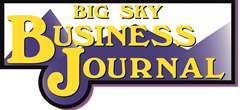SD Studio, 912 Dorothy Ln, 59105, 690-1230, Susan Martinez, service
Element Skin Therapy, 411 24th St W Ste 113, 59102, 208-7822, Iverson Kialy, service
A’s Auto Detailing, 1724 1st Ave N, 59101, 661-3581, Conner Albright, service
US 48 Capital LLC, 1825 Grand Ave Ste 127, 800-6635, 59102, Mikael Tashchyan, service
Pet Passages, 2223 1st Ave N, 59101, 697-1465, James and Mark Barnes, service
Grizzly Metals, 6624 S Frontage Rd, 59101, 998-8281, Brandon Marks, service
Blackrock Tython LLC, 18 Burlington Ave, 59101, 696-4865, Ricco Brown, real estate rental
Iris Massage and Wellness LLC, 1780 Shiloh Rd #A, 59106, 794-6770, Jysten Thompson, solo practitioner
Lewis Foods LLC, 670 S 24th St W, 59102, 598-6665, Lee Lewis, restaurants
Regenmed MT LLC, 2345 King Ave w Ste D, 59102, 201-9787, Michael Matthews, service
Sports Clips, 315 Main St, 59105, 248-2488, C&B Hauser Inc – Casey Carnahan, cosmetology
Altitude MT LLC, 127 Saddle tree Place, 59106, 200-8204, Cassidy Haberman, service
Michelle Wilkins Massage Therapy, 928 Broadwater #204, 59102, Michelle Wilkins, solo practitioner
Paragon Construction Company MT, LLC, 2656 E Denim Trl, San Tan Valley 85143, 480-364-4300, Crystal Ferns, general contractor
Big Sky Home Rentals LLC, 612 Miles Ave, 59101, 647-0239, Jeff Lasher, real estate rental
Slick Mobile Detail Services LLC, 212 Terry Ave, 59101, 500-6181, service
Yellowstone Narcotics LLC, 3313 Rimrock Rd, 59102, 530-961-2001, Cameron Pavlicek, service
Diamond Auto and Diesel Repair LLC, 830 W Toy Storage Unit C, 59106, 899-2426, Stephanie Johnson, auto business
Elementum Massage, 1629 Ave D Ste A5, 59102, 534-2660, Kyle Buffington, solo practitioner
The Maker’s Market, 4220 State Ave, 59101, 561-3427, Victoria Eichel, retail sales
Elementum Massage (Loretta Lehman), 1929 Ave D Ste A5, 59102, 534-2660, Loretta Lehman, solo practitioner
B-Town Cleaning, 3540 Monad Rd #8, 672-3151, Jonathan Collins, service
Riley Tree Service, 2933 Terry Ave, 59102, 545-8386, Steven Riley, service
Longs Masonry, 2317 Yellowstone Ave, 59102, 794-1948, Alexander Long, general contractor
Beartooth Exterior Cleaning, 5049 Danford Dr, 59106, 839-8736, Jordan Maher, service
Two Lane Services, 548 Orchard Lane, 59101, 561-0849, Lindsey Lane, retail sales
JK Construction MT LLC, 127 Saddle Tree Place, 59106, 200-8283, Cassidy Haberman, general contractor
Matt’s Pest Management LLC, 127 Saddle Tree Place, 59106, 200-8214, Cassidy Haberman, service
Alloy Personal Training, 4011 Montana Sapphire Dr, 59106, 296-6667, Casey Kelly, service
Green FBA Enterprises, 923 Avenue D, 59102, 402-914-7289, Aaron Green, retail sales
DCL Operating LLC (Speedy Ship), 2505 6th Ave N, 59101, 671-8069, Scott Urgin, service
RPM Elite Construction, 3385 Granger Ave S #10, 59102, 509-980-1405, Ryan Meyer, general contractor
Short Corner Capital LLC, 1430 Lynn Ave, 59102, 671-9620, Doug Enderson, real estate rental
Wanderluxe, 182 S 32nd St W Unit 5, 59102, 530-5096, Carissa Cardiff, service
All About You Parties and Events, 3715 Parkhill Dr, 59102, 200-8166, Stephen Marshall, service
Yeaman Lawm Care and Snow Removal, 695 Indian Trail, 59105, 850-2589, Carver Yeoman, service
Higgs LLC, 942 Burlington, 59101, 413-0504, Danielle Higgs, service
RVR Properties, 5087 Dovetail Ave, 59106, 690-0087, Reginald Hague, service
Fever Prep & Paint, 637 Chokecherry Pl, 59102, 201-0075, Dalton Hagadone, service
Empty It out Junk Removal, 2002 Woody Dr #21, 59102, 670-6822, Kristopher Hasler, service
Treasure Home Security Firm, 44 6th St W #5, 59101, 901-8689, John Abraham, service
Cari’s Homemade Bakery LLC, 329 Stewart Court N, 59106, 672-4822, Cari Johnson, retail sales
Glory Wellness Services LLC, 3210 Henesta Dr, 545-3448, Shay Osborne, service
Sum-It Bookkeeping and Mobile Notary Services LLC, 2038 Lewis Ave, 59102, 694-3566, Gina Francis, service
Anderson Towing 10, 1202 S 32nd St W, 59106, 534-2478, Cameron Cochran, service
Anderson Towing 11, 1202 S 32nd St W, 59106, 534-2478, Cameron Cochran, service
Anderson Towing 12, 1202 S 32nd St W, 59106, 855-8661, Cameron Cochran, service
Candace Durand, 2302 rosebud Dr, 59102, 855-8300, Candace Durand, service
PWR Contracting, 928 Broadwater Ave Ste 201, 59101, 208-2697, Koby Jeffers, general contractor
Montana Plants, 421 Sioux Lane, 59105, 661-0322, Tanya Debuff Wallette, retail sales
406 Native Roots, 5320 Vintage Ln, 59106, 876-2086, Alena Hawley, retail sales
IG Cleaning, 4142 Buchanan Ave, 59101, 876-3800, Isaac Guzman, service
Electric Storm Gallery, 405 N 24th St, 59101, 503-970-4981, Taylor Evans, retail sales
Jetset Fitness, 415 Wyoming Ave, 59101, 998-8582, Andrew Jetmore, service
Little Hands Early Learning, 44 Nimitz Dr, 59101, 671-9101, Patrick Wright, service
Daily Dog Hikes, 1224 Lewis Ave, 59102, 702-6992, Aubrey Nesheim, service
Montana Metal Creations, 3433 Pebble Brook Dr, 59101, 794-5961, Michael Volmer, retail sales
Greenhouse Creations, 1010 Moon Valley Rd, 59105, 606-2428, Tamara Nunley, retail sales
Garrett Excavating & Trucking Inc, 629 Rapelje Rd, Columbus 59019, 671-0534, Paul Gairrett, service
Kokaine Kicks, 209 N 29th St, 59101, 661-4294, Jesse Perez, antique and second hand store
Yellow Ball Roofing and Solar LLC, 2617 Meadow Creek Loop, 59105, 200-2093, general contractor
Risingsuns Exterior and Interior LLC, 1015 Shinn Rd, 59105, 839-3369, Irvin Chris Risingsun III, general contractor
Cindy and David Roberts Airbnb, 6046 Norma Jean Ln, 59101, 425-1253, David & Cindy Roberts, real estate rental
Waymire LLC, 942 Burlington Ave, 59101, 200-5999, Katina Waymire, service
Alpine Home Renovations LLC, 5415 Quarry Stone Ave, 59106, 876-5688, Clayton Barrett, general contractor
Diamond Automotive Center (Repair), 2924 1st Ave N, 59101, 856-3970, William Dalton, service
Diamond Automotive Center (Sales), 2924 1st Ave N, 59101, 256-3970, William Dalton, retail sales
Integrity Business Services LLC, 3106 Copper Ridge Place, 59106, 425-2519, Natasha Abel, service
Moon Massage, 605 24th St W Ste 2, 59102, 534-2755, Hui Wang, massage facility license
Business Basics, 3003 Ave F, 59102, 850-3549, Katherine Hemphill, service
MT Counseling, 3610 Barry Dr, 59102, 697-2530, Kristie Thomas, service
Big Sky Backyards, 128 S 28th St, 59101, 545-7327, Alec Schiffner, service
Glassing Custom Construction LLC, 2007 19th St W, 59102, 470-1081, Jonathon Glassing, general contractor
406 Bubble Studz, 930 Rex Ln, 59105, 808-9207, Jazmine Pewitt/Jacquelin Matte, service
Design North Supply, 1300 Lockwood Rd, 59101, 794-1735, Jason Spiller, retail sales
T Castro Guitar Lesson, 208 Terry Ave, 59101, 690-0378, service
Western Sky Billings LLC, 4610 Crescent, 59106, 748-3016, Donald Drake, service
4th Avenue Inn LLC, 2601 4th Ave N, 59101, 855-1745, Craig Barthel, service
Skechers retail USA LLC, 2395 Rosebud Dr, 59102, 545-6121, Rochelle Boykin, retail sales
Alpine exteriors, 2411 Hillner, 59101, 598-8905, Ree Lapham, general contractor
Buckmiller Construction, 3326 Winchell Ln, 59102, 860-5150, Boone Buckmiller, general contractor
Platinum HVAC LLC, 1733 Alderson Ave, 59102, 671-8446, Angelo Mota, service
The Puppy Parlor, 706 Central Ave, 59102, 307-921-9075, Shantel Hessenthaler, service
Mid West Transport LLC, 519 ½ S 32nd St, 59101, 413-5013, Richard Savaria, service
A1 Vending Solutions, 1333 N 27th St Apt 1, 59101, 696-6106, Blaine McCue, retail sales
Heidema & Co, 5724 Yeoman Rd, Shepherd 59079, 860-1941, Blair Walters, retail sales
406 Premier Prep LLC, 1006 Toole Circle, 59105, 350-0887, David Inman, service
MTS Laser & Crafts, 1516 Anchor Ave, 59105, 671-5424, Troy Smith, retail sales
406 Diamond Auto detailing, 313 Stewart Ct, 59105, 670-0246, Yousif Aldabbagh, service
Smartstyle (Main St ), 1649 Main St, 59105, 248-3644, Venita Group, cosmetology
Smartstyle (King Ave), 2525 King Ave West, 59102, 652-3775, Venita Group, cosmetology
KDSellers, 1119 Arlington Ave SW, 59101, 425-0665, David Baumann, retail sales
Esthetics by Julia, 71 25th St W Ste 1, 59102, 647-5697, Julia Lave, service
The Locker Room, 905 Grand Ave, 59102, 850-2893, Travis Carpenter, service
Golden Hollow Cottage STR, 5241 Golden Hollow Rd, 59101, 690-4115, Jason Kleinschmidt, real estate rental
Let’s Get Fresh, 1435 Colton Blvd, 59102, 561-3392, Sharli Kiner, restaurants



